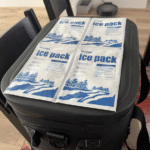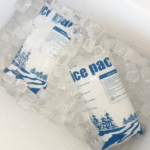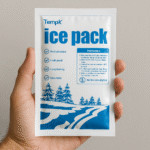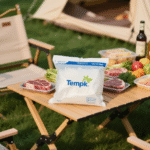Reusable Dry Ice Packs for Fish Shipping: How to Keep Seafood Frozen
Keeping seafood frozen when it travels is crucial for taste and safety. Reusable dry ice packs for fish make it simple and cost effective by delivering ultra cold temperatures without mess. In this guide you’ll learn why dry ice packs work better than regular ice, how to pack fish properly and how 2025 innovations can boost your cold chain. Get ready to keep your fish shipments frozen and customers happy.

Apa itu kantong es kering yang dapat digunakan kembali dan bagaimana cara kerjanya?—understanding solid CO₂ sublimation for fish shipments
Why choose dry ice packs over gel packs or water ice?—comparing cooling duration, temperature range and moisture
How to pack fish safely with dry ice packs?—calculating quantities, layering techniques and ventilation
Which dry ice pack suits your seafood?—choosing by fish type, shipment duration and sustainability goals
What are the latest cold chain trends for fish?—smart monitoring, eco friendly CO₂ and hybrid cooling
What Are Reusable Dry Ice Packs for Fish and How Do They Work?
Defining dry ice packs in plain terms
Dry ice packs are sheets or bricks containing solid carbon dioxide (Co₂) that sublimate from a solid directly into a gas, menjaga suhu yang sangat rendah. When used in a vented bag or pack, the CO₂ gas escapes while cold air sinks around your fish. Unlike frozen water, es kering tidak meleleh menjadi cairan, so it avoids soggy packages and prevents bacterial growth. These packs typically sublimate at –78.5 ° C. (–109,3°F), making them ideal for keeping fish frozen during long shipments.
Reusable dry ice packs use durable materials and vented designs so they can be recharged—after the CO₂ sublimates completely, you can refill or replace the dry ice pellets. This reduces waste and saves money over single use blocks. When refreezing, ensure the pack is fully sublimated and dry before adding fresh dry ice.
How reusable dry ice packs compare to gel packs for fish
Gel packs are flexible pouches filled with a non toxic gel that freezes and maintains cold temperatures around 0 °C–8 °C (32 °F–46 °F). They are reusable and non toxic, making them great for chilled seafood or short distance deliveries. Paket es kering, Namun, maintain temperatures below –78.5 °C and last 24–48 hours or more, making them indispensable for frozen fish or long distance shipments. Gel packs generate meltwater and may allow temperature fluctuations, whereas dry ice packs leave no residue.
| Metode pendinginan | Kisaran suhu | Lamanya | Kelembaban | Practical Use |
| Paket es kering | –78.5 ° C. (–109 ° F.) | 24–48 jam, up to 72 hours in optimal conditions | Tidak ada (Subledlimates) | Best for frozen fish or long distance shipments; compact and residue free |
| Paket gel | 0 °C–8 °C (32 °F–46 °F) | 6–12 hours | Produces meltwater | Ideal for chilled seafood or short trips; reusable and flexible |
| Water ice pack | ~ 0 ° C. (32 ° f) | 6–8 hours | Meleleh menjadi cair | Low cost option for non perishable or local deliveries |
Why sublimation matters for fish
Dry ice goes directly from a solid to a gas. Karena menyublimkan, dia menyerap panas from your fish, keeping the product frozen. The cold CO₂ gas sinks within the container, forming a “cold dome” over your fish. Because there’s no melting, your packaging stays dry and your fish arrive without water damage.
Practical tip for you
Use a reusable dry ice pack when shipping frozen fish across country or internationally; the ultra low temperature prevents thawing during multi day transit.
Choose gel packs for fresh or live seafood; they maintain chilled temperatures without freezing the product.
Kasus aktual: A seafood distributor shipping fresh tuna overseas used reusable dry ice packs combined with insulated liners. The fish arrived frozen after a 48 hour journey, with no water residue and satisfied customs inspections—proving the effectiveness of sublimation based cooling.
Why Are Reusable Dry Ice Packs Essential for Shipping Fish?
Maintaining food safety and quality
Fish is highly perishable and must be kept at sub zero temperatures to prevent bacterial growth and spoilage. Dry ice packs maintain consistent temperatures below –18 °C, ensuring frozen fish stay solid and fresh. Traditional gel packs or water ice can allow the temperature to fluctuate, risking partial thawing and compromising quality.
Key benefits for seafood logistics
Durasi pendinginan yang diperpanjang: Es kering bertahan lebih lama dibandingkan es biasa; the sublimation process can provide continuous cooling for 24–48 hours or even up to 72 hours with the right pack size.
No residue or contamination: Because dry ice sublimates, it leaves tidak ada cairan behind, avoiding soggy packaging and reducing the risk of bacteria.
Kompak dan ringan: Paket es kering adalah space saving, maximizing shipment volume and reducing shipping costs.
Reusable option: Many dry ice pack products are dapat digunakan kembali, allowing you to recharge them with new CO₂ pellets after each trip. This reduces waste and long term costs.
Use cases by fish type
Reusable dry ice packs suit different kinds of fish:
Fresh fish: Pre chilled fish require just-above-freezing temperatures. Dry ice packs maintain a cool environment to prevent spoilage while avoiding thawing.
Ikan beku: Frozen fish must remain below –18 °C. Dry ice packs maintain sub zero temperatures to prevent thawing.
Processed fish products: Smoked fish or fillets need stable cold conditions to preserve quality. Dry ice provides consistent cooling.
Untuk tipnya
When shipping live fish or shellfish, do not use dry ice. The extreme cold can harm the animals. Alih-alih, use gel packs or water ice to maintain a chilled but not frozen environment.
How Much Dry Ice to Use and Best Practices for Packing Fish
Determining the required cooling capacity
Estimating how much dry ice you need is crucial for cost effective and safe shipments. A general rule is 5–10 pounds of dry ice for every 15 quarts of cooler space per 24 hour transit. For longer journeys or hot climates, increase the amount proportionally.
UPS’s guidelines suggest five to ten pounds of dry ice will sublimate every 24 hours, depending on the density of the insulated container. They recommend adding enough dry ice to cover an extra 24 jam in case of delays. Insulated Products Corporation also notes that using equal weight dry ice and payload will keep the product frozen for up to 48 jam, Dan one and a half times the weight is needed for 72 hour shipping.
Proper packaging and layering technique
Follow these steps to maximize performance:
Choose quality insulation: Use containers made from expanded polystyrene (EPS) or polyurethane for thermal resistance. Avoid airtight boxes—leave room for gas to escape.
Pre freeze and pre chill: Always freeze the fish and chill your container before packing; this reduces the initial temperature load.
Layer your shipment:
Lapisan bawah: Place foam or cardboard to create a buffer.
Middle layer: Arrange fish pieces evenly with space for air circulation.
Lapisan atas: Position dry ice packs on top to create a cold dome, allowing the cold air to sink around the fish.
Fill void spaces: Use crumpled paper or extra insulation to eliminate air gaps and reduce dry ice consumption.
Sediakan ventilasi: Leave vents or small cracks in the container lid so CO₂ gas can escape, preventing pressure build up. Never seal a dry ice box airtight.
Separate dry ice from fish: Use a spacer or layer of cardboard to prevent direct contact. Dry ice’s extreme cold can cause freezer burn if it touches fish.
Gunakan pencatat data: Attach a temperature logger to monitor conditions throughout the journey; this helps you validate your process and comply with regulations.
Regulatory and safety considerations
Hazard classification: Es kering tergolong bahan berbahaya (Dan1845). AS. Code of Federal Regulations and IATA rules limit air shipments to about 2.5 kg (5.5 lb) es kering per paket.
Handling precautions: Kenakan sarung tangan pelindung, kacamata dan baju lengan panjang untuk mencegah radang dingin. Use tongs when possible, and never handle dry ice with bare hands.
Ventilation and storage: Store dry ice in well ventilated areas and non airtight containers. CO₂ gas can accumulate and cause pressure build up or asphyxiation.
Pembuangan: Let leftover dry ice sublimate outdoors or in a well ventilated space; never dispose of it in sinks or trash bins.
Kasus aktual: A small fishery once sealed a dry ice package too tightly. The CO₂ gas built up and burst the box during transit. By following proper venting and labeling guidelines, you can avoid such accidents and keep your shipments safe for carriers and customers.
Choosing the Right Reusable Dry Ice Pack for Different Fish Shipments
Assess shipment duration and temperature requirements
Perjalanan singkat (under 24 hours): For local deliveries or overnight shipments, use dry ice amounting to half the weight of your fish to keep it frozen.
Medium trips (24–48 jam): Equal weight of dry ice and fish maintains freezing for up to 48 hours.
Perjalanan yang diperpanjang (48–72 jam): Menggunakan 1.5 times the weight of your fish in dry ice to maintain freezing for 72 hours. Add gel packs to slow sublimation and prolong cooling.
Match pack size to fish volume
Consider the size of your shipment: larger shipments require multiple reusable packs to distribute cooling evenly. For small or moderate shipments, one pack might suffice. Always ensure each pack is fully charged with dry ice pellets before use.
Factor in fish type and customer needs
Premium fillets and delicate fish: Use extra insulation and more dry ice to prevent any temperature rise; customers paying for premium seafood expect pristine quality.
Bulk frozen fish: Efficiency matters; choose larger packs or multiple smaller packs to maximize container space and minimize cost per pound.
Sustainable-minded clients: Select packs made from recyclable materials or eco friendly dry ice produced via carbon capture processes. Communicate this sustainability effort to customers to enhance brand value.
Consider reusability and sustainability
Reusable dry ice packs reduce environmental impact by allowing repeated use. Some manufacturers now offer smart dry ice packs with built in sensors that monitor temperature and alert you if conditions deviate. Others use biodegradable CO₂ to minimize emissions. Saat memilih paket, evaluate durability, ease of recharging and end of life recyclability.
2025 Trends in Reusable Dry Ice Packs and Cold Chain Logistics for Fish
Tinjauan Tren
The seafood industry is experiencing rapid innovation in cold chain logistics. Emerging technologies are making shipping safer, greener and more efficient. Inisiatif keberlanjutan are driving adoption of biodegradable dry ice and carbon capture manufacturing processes. Pemantauan Cerdas uses IoT sensors to track temperature in real time, ensuring compliance and reducing spoilage. Solusi pendinginan hibrida menggabungkan es kering dengan bahan pengubah fasa (PCM) or gel packs to extend cooling time and reduce the amount of dry ice needed.
Sekilas
Smart dry ice packs: Equipped with IoT sensors, these packs provide real time temperature data and alerts if the shipment leaves the safe range.
Eco friendly CO₂ production: Innovations use renewable energy and carbon capture to produce dry ice, reducing the carbon footprint of shipping.
Pendinginan hibrida: Combining dry ice with gel packs or PCM extends cooling duration and reduces dry ice consumption.
AI driven cold chain optimization: Artificial intelligence optimizes routes, predicts delays and adjusts cooling needs, ensuring fish arrives fresh.
Wawasan pasar
Growing consumer demand for fresh, sustainably sourced seafood is pushing the cold chain market to adopt reusable packaging and advanced monitoring. Reusable packs and smarter logistics not only reduce waste but also biaya pengiriman yang lebih rendah by reducing spoilage and returns. Expect the market for reusable cold chain packaging to expand significantly over the next decade as regulations emphasize carbon reduction and consumers favor sustainable practices.
Pertanyaan yang sering diajukan
How long will reusable dry ice packs keep fish frozen? Dry ice packs can keep fish frozen for 24–48 jam, and up to 72 hours when using larger quantities or combining with gel packs.
Apakah kantong es kering aman untuk ditangani? Ya, if handled correctly. Always wear protective gloves and goggles, and avoid direct contact with bare skin. Provide ventilation to release CO₂ gas.
Dapatkah saya menggunakan kembali paket es kering? Ya. After the dry ice fully sublimates, allow the pack to dry and recharge it with new CO₂ pellets. Ensure there is no moisture or damage before reuse.
Is dry ice suitable for live fish or shellfish? TIDAK. The extreme cold can harm live seafood. Use gel packs or water ice instead.
What regulations apply to dry ice shipments? Dry ice is a hazardous material (Dan1845). Air shipments are typically limited to 2.5 kg (5.5 lb) per paket and require specific labeling.
Ringkasan
Reusable dry ice packs are a powerful tool for preserving the quality of fish during transport. Mereka maintain ultra low temperatures without moisture, menawarkan extended cooling durations, Dan Kurangi limbah when reused. Oleh menghitung jumlah es kering yang tepat, layering your shipment properly and ensuring ventilation, you can keep fish frozen for days. With emerging trends like smart sensors and eco friendly CO₂ production, reusable dry ice packs will continue to improve. Untuk hasil terbaik, evaluate your shipment needs, choose high quality insulation and stay informed about regulatory updates.
Langkah selanjutnya:
Nilai kiriman Anda: Determine whether your fish require freezing or chilling, and calculate the needed dry ice weight accordingly.
Tingkatkan kemasan Anda: Invest in durable, reusable dry ice packs and insulated containers to improve efficiency.
Implement monitoring: Use temperature loggers or smart packs to track conditions and adjust processes in real time.
Stay sustainable: Explore eco friendly dry ice sources and recycling options to reduce environmental impact.
Get professional support: Consult with cold chain experts to tailor a solution for your business.
ABout Temprk
Kami berspesialisasi dalam advanced cold chain logistics for seafood, pharmaceuticals and other perishable goods. Paket es kering kami yang dapat digunakan kembali, insulated boxes and smart monitoring tools help you maintain product integrity while lowering costs. We’re committed to sustainability by offering eco friendly materials and cutting edge technology. Dengan keahlian kami, you can ship fish confidently, knowing it will arrive frozen, safe and ready for consumers.
Panggilan untuk bertindak: Explore our products and speak with a Tempk consultant today to optimize your fish shipping process.























